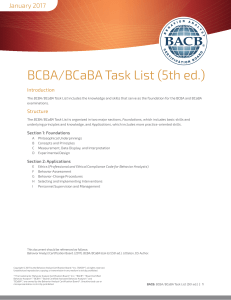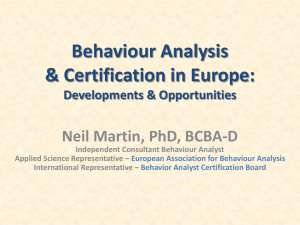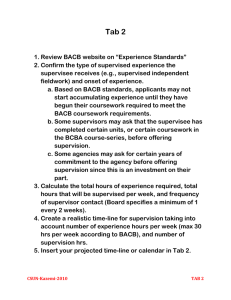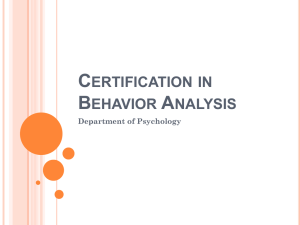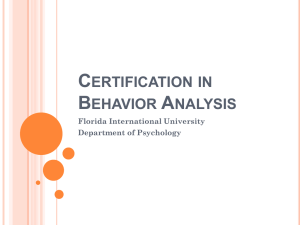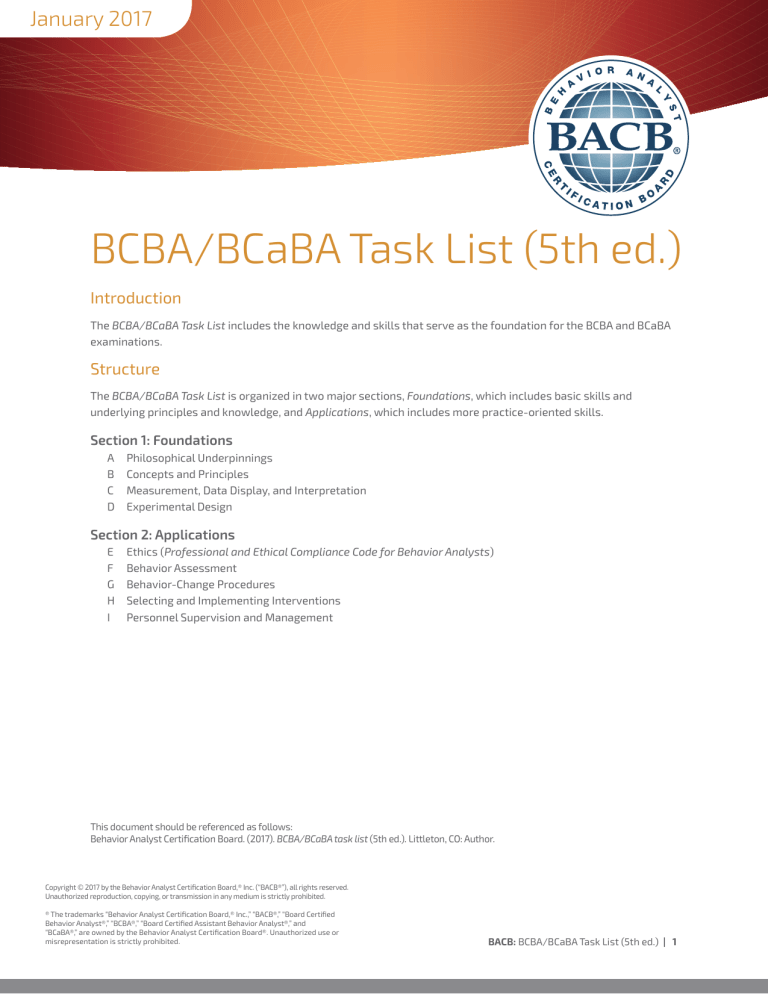
January 2017
BCBA/BCaBA Task List (5th ed.)
Introduction
The BCBA/BCaBA Task List includes the knowledge and skills that serve as the foundation for the BCBA and BCaBA
examinations.
Structure
The BCBA/BCaBA Task List is organized in two major sections, Foundations, which includes basic skills and
underlying principles and knowledge, and Applications, which includes more practice-oriented skills.
Section 1: Foundations
A
B
C
D
Philosophical Underpinnings
Concepts and Principles
Measurement, Data Display, and Interpretation
Experimental Design
Section 2: Applications
E
F
G
H
I
Ethics (Professional and Ethical Compliance Code for Behavior Analysts)
Behavior Assessment
Behavior-Change Procedures
Selecting and Implementing Interventions
Personnel Supervision and Management
This document should be referenced as follows:
Behavior Analyst Certification Board. (2017). BCBA/BCaBA task list (5th ed.). Littleton, CO: Author.
Copyright © 2017 by the Behavior Analyst Certification Board,® Inc. (“BACB®”), all rights reserved.
Unauthorized reproduction, copying, or transmission in any medium is strictly prohibited.
® The trademarks “Behavior Analyst Certification Board,® Inc.,” “BACB®,” “Board Certified
Behavior Analyst®,” “BCBA®,” “Board Certified Assistant Behavior Analyst®,” and
“BCaBA®,” are owned by the Behavior Analyst Certification Board®. Unauthorized use or
misrepresentation is strictly prohibited.
BACB: BCBA/BCaBA Task List (5th ed.) | 1
Section 1: Foundations
A. Philosophical Underpinnings
A-1
Identify the goals of behavior analysis as a science (i.e., description, prediction, control).
A-2
Explain the philosophical assumptions underlying the science of behavior analysis (e.g., selectionism,
determinism, empiricism, parsimony, pragmatism).
A-3
Describe and explain behavior from the perspective of radical behaviorism.
A-4
Distinguish among behaviorism, the experimental analysis of behavior, applied behavior analysis, and
professional practice guided by the science of behavior analysis.
A-5
Describe and define the dimensions of applied behavior analysis (Baer, Wolf, & Risley, 1968).
B. Concepts and Principles
B-1
Define and provide examples of behavior, response, and response class.
B-2
Define and provide examples of stimulus and stimulus class.
B-3
Define and provide examples of respondent and operant conditioning.
B-4
Define and provide examples of positive and negative reinforcement contingencies.
B-5
Define and provide examples of schedules of reinforcement.
B-6
Define and provide examples of positive and negative punishment contingencies.
B-7
Define and provide examples of automatic and socially mediated contingencies.
B-8
Define and provide examples of unconditioned, conditioned, and generalized reinforcers and punishers.
B-9
Define and provide examples of operant extinction.
B-10
Define and provide examples of stimulus control.
B-11
Define and provide examples of discrimination, generalization, and maintenance.
B-12
Define and provide examples of motivating operations.
B-13
Define and provide examples of rule-governed and contingency-shaped behavior.
B-14
Define and provide examples of the verbal operants.
B-15
Define and provide examples of derived stimulus relations.
C. Measurement, Data Display, and Interpretation
C-1
Establish operational definitions of behavior.
C-2
Distinguish among direct, indirect, and product measures of behavior.
C-3
Measure occurrence (e.g., frequency, rate, percentage).
C-4
Measure temporal dimensions of behavior (e.g., duration, latency, interresponse time).
C-5
Measure form and strength of behavior (e.g., topography, magnitude).
Copyright © 2017 by the Behavior Analyst Certification Board,® Inc. (“BACB®”), all rights reserved.
Unauthorized reproduction, copying, or transmission in any medium is strictly prohibited.
BACB : BCBA/BCaBA Task List (5th ed.) | 2
C-6
Measure trials to criterion.
C-7
Design and implement sampling procedures (i.e., interval recording, time sampling).
C-8
Evaluate the validity and reliability of measurement procedures.
C-9
Select a measurement system to obtain representative data given the dimensions of behavior and the logistics of observing and recording.
C-10
Graph data to communicate relevant quantitative relations (e.g., equal-interval graphs, bar graphs, cumulative records).
C-11
Interpret graphed data.
D. Experimental Design
D-1
Distinguish between dependent and independent variables.
D-2
Distinguish between internal and external validity.
D-3
Identify the defining features of single-subject experimental designs (e.g., individuals serve as their own controls, repeated measures, prediction, verification, replication).
D-4
Describe the advantages of single-subject experimental designs compared to group designs.
D-5
Use single-subject experimental designs (e.g., reversal, multiple baseline, multielement, changing criterion).
D-6
Describe rationales for conducting comparative, component, and parametric analyses.
Section 2: Applications
E. Ethics
Behave in accordance with the Professional and Ethical Compliance Code for Behavior Analysts.
E-1
Responsible conduct of behavior analysts
E-2
Behavior analysts’ responsibility to clients
E-3
Assessing behavior
E-4
Behavior analysts and the behavior-change program
E-5
Behavior analysts as supervisors
E-6
Behavior analysts’ ethical responsibility to the profession of behavior analysis
E-7
Behavior analysts’ ethical responsibility to colleagues
E-8
Public statements
E-9
Behavior analysts and research
E-10
Behavior analysts’ ethical responsibility to the BACB
Copyright © 2017 by the Behavior Analyst Certification Board,® Inc. (“BACB®”), all rights reserved.
Unauthorized reproduction, copying, or transmission in any medium is strictly prohibited.
BACB : BCBA/BCaBA Task List (5th ed.) | 3
F. Behavior Assessment
F-1
Review records and available data (e.g., educational, medical, historical) at the outset of the case.
F-2
Determine the need for behavior-analytic services.
F-3
Identify and prioritize socially significant behavior-change goals.
F-4
Conduct assessments of relevant skill strengths and deficits.
F-5
Conduct preference assessments.
F-6
Describe the common functions of problem behavior.
F-7
Conduct a descriptive assessment of problem behavior.
F-8
Conduct a functional analysis of problem behavior.
F-9
Interpret functional assessment data.
G. Behavior-Change Procedures
G-1
Use positive and negative reinforcement procedures to strengthen behavior.
G-2
Use interventions based on motivating operations and discriminative stimuli.
G-3
Establish and use conditioned reinforcers.
G-4
Use stimulus and response prompts and fading (e.g., errorless, most-to-least, least-to-most, prompt delay, stimulus fading).
G-5
Use modeling and imitation training.
G-6
Use instructions and rules.
G-7
Use shaping.
G-8
Use chaining.
G-9
Use discrete-trial, free-operant, and naturalistic teaching arrangements.
G-10
Teach simple and conditional discriminations.
G-11
Use Skinner’s analysis to teach verbal behavior.
G-12
Use equivalence-based instruction.
G-13
Use the high-probability instructional sequence.
G-14
Use reinforcement procedures to weaken behavior (e.g., DRA, FCT, DRO, DRL, NCR).
G-15
Use extinction.
G-16
Use positive and negative punishment (e.g., time-out, response cost, overcorrection).
G-17
Use token economies.
G-18
Use group contingencies.
G-19
Use contingency contracting.
G-20
Use self-management strategies.
Copyright © 2017 by the Behavior Analyst Certification Board,® Inc. (“BACB®”), all rights reserved.
Unauthorized reproduction, copying, or transmission in any medium is strictly prohibited.
BACB : BCBA/BCaBA Task List (5th ed.) | 4
G-21
Use procedures to promote stimulus and response generalization.
G-22
Use procedures to promote maintenance.
H. Selecting and Implementing Interventions
H-1
State intervention goals in observable and measurable terms.
H-2
Identify potential interventions based on assessment results and the best available scientific evidence.
H-3
Recommend intervention goals and strategies based on such factors as client preferences, supporting
environments, risks, constraints, and social validity.
H-4
When a target behavior is to be decreased, select an acceptable alternative behavior to be established or
increased.
H-5
Plan for possible unwanted effects when using reinforcement, extinction, and punishment procedures.
H-6
Monitor client progress and treatment integrity.
H-7
Make data-based decisions about the effectiveness of the intervention and the need for treatment
revision.
H-8
Make data-based decisions about the need for ongoing services.
H-9
Collaborate with others who support and/or provide services to clients.
I. Personnel Supervision and Management
I-1
State the reasons for using behavior-analytic supervision and the potential risks of ineffective supervision
(e.g., poor client outcomes, poor supervisee performance).
I-2
Establish clear performance expectations for the supervisor and supervisee.
I-3
Select supervision goals based on an assessment of the supervisee’s skills.
I-4
Train personnel to competently perform assessment and intervention procedures.
I-5
Use performance monitoring, feedback, and reinforcement systems.
I-6
Use a functional assessment approach (e.g., performance diagnostics) to identify variables affecting
personnel performance.
I-7
Use function-based strategies to improve personnel performance.
I-8
Evaluate the effects of supervision (e.g., on client outcomes, on supervisee repertoires).
Copyright © 2017 by the Behavior Analyst Certification Board,® Inc. (“BACB®”), all rights reserved.
Unauthorized reproduction, copying, or transmission in any medium is strictly prohibited.
® The trademarks “Behavior Analyst Certification Board,® Inc.,” “BACB®,” “Board Certified
Behavior Analyst®,” “BCBA®,” “Board Certified Assistant Behavior Analyst®,” and
“BCaBA®,” are owned by the Behavior Analyst Certification Board®. Unauthorized use or
misrepresentation is strictly prohibited.
BACB : BCBA/BCaBA Task List (5th ed.) | 5

